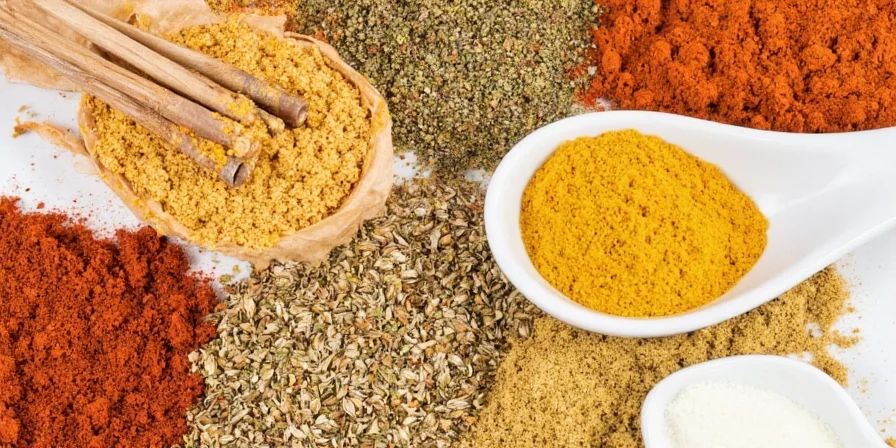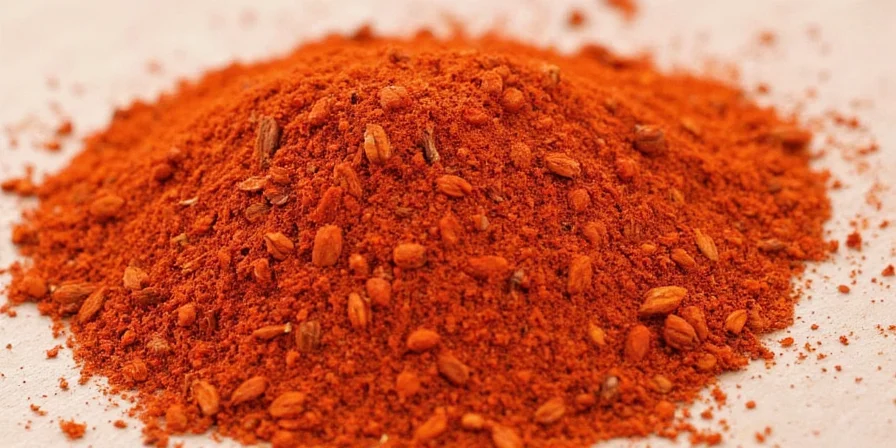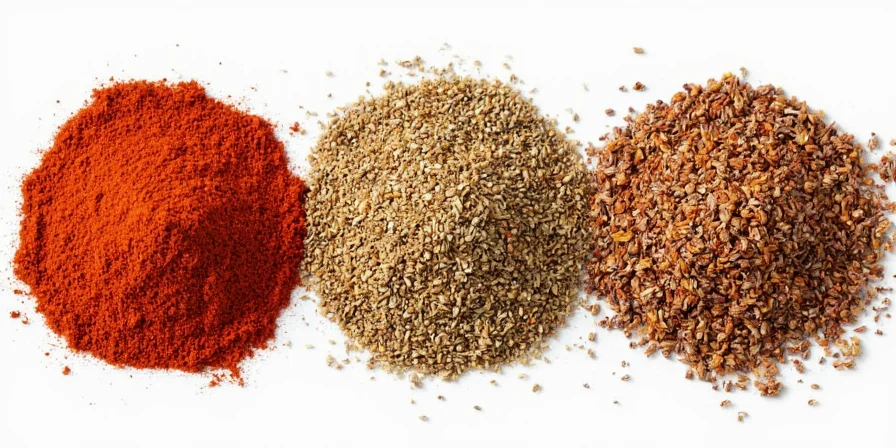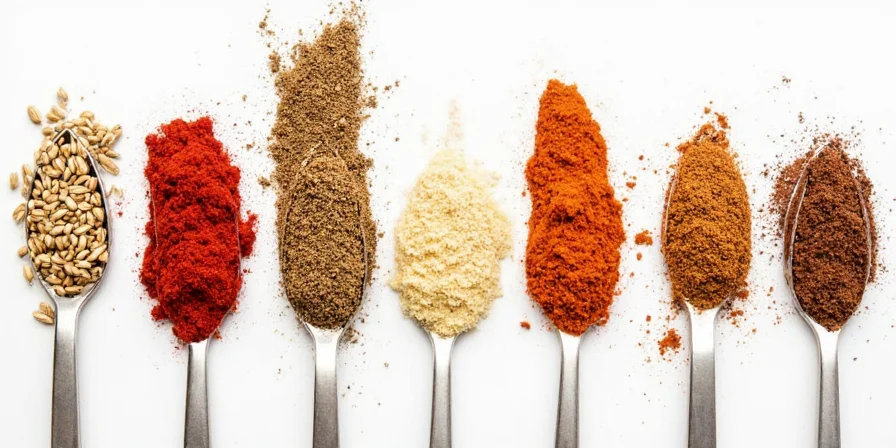Looking for the essential spices every home cook needs? Start with these seven kitchen staples that form the foundation of nearly every cuisine worldwide. This guide delivers exactly what you need: which spices to buy, how to use them properly, and common mistakes to avoid - with clear, actionable advice you can implement today. Skip the fluff and get straight to building better flavor in your everyday cooking.
Table of Contents
- The 7 Essential Spices Checklist
- 1. Black Pepper – Your Most Versatile Seasoning
- 2. Cumin – The Secret to Depth in Everyday Cooking
- 3. Paprika – Instant Color and Flavor Booster
- 4. Turmeric – The Golden Health Powerhouse
- 5. Coriander – The Balancing Spice You're Missing
- 6. Chili Powder – Controlled Heat Made Simple
- 7. Garlic Powder – Consistent Flavor Without the Bite
- Quick Reference Guide
- Proper Storage Techniques
- Top 5 Spice Mistakes to Avoid
- Simple Starter Recipes
The 7 Essential Spices Checklist
Before diving into details, here's exactly what to buy for your basic spice pantry. These seven spices cover 90% of cooking needs across global cuisines, cost under $25 total, and last 6-12 months when stored properly:
- Whole black peppercorns (not pre-ground)
- Ground cumin
- Sweet paprika
- Turmeric powder
- Coriander powder
- Chili powder (not cayenne)
- Garlic powder
Pro Tip: Purchase small quantities (1-2 oz) from stores with high turnover like Penzeys or The Spice House to ensure freshness. Avoid grocery store spice aisles where inventory often sits for years.

1. Black Pepper – Your Most Versatile Seasoning
Why it's essential: More than just heat, black pepper enhances other flavors and works in both savory and sweet dishes. It's the most widely used spice globally for good reason.
What to buy: Whole peppercorns in a grinder (avoid pre-ground pepper which loses 70% of flavor within weeks)
How to use it properly:
- Add at the end of cooking for maximum flavor impact
- Grind directly onto food rather than into bowls
- Use 3-4 turns of grinder per serving for perfect seasoning
Common mistake: Adding pepper too early in cooking - most volatile compounds evaporate during cooking, leaving little flavor.

2. Cumin – The Secret to Depth in Everyday Cooking
Why it's essential: Cumin adds earthy depth to beans, meats, and vegetables. It's the backbone of chili, taco seasoning, and many curry blends.
What to buy: Ground cumin (seeds are hard to find consistently fresh)
How to use it properly:
- Toast in dry pan 60 seconds before using for richer flavor
- Add early in cooking to allow flavors to develop
- Use 1/4 teaspoon per serving as a starting point
Common mistake: Using too much - cumin quickly becomes overpowering. Start with less than you think you need.

3. Paprika – Instant Color and Flavor Booster
Why it's essential: Paprika adds vibrant color and subtle flavor to dishes from deviled eggs to roasted meats. It's the secret to professional-looking home cooking.
What to buy: Sweet paprika (avoid smoked or hot versions for your basic pantry)
How to use it properly:
- Sprinkle on finished dishes for color impact
- Mix with oil to create flavorful marinades
- Use 1/2 teaspoon per serving as base seasoning
| Type | Best For | When to Add |
|---|---|---|
| Sweet Paprika | Everyday cooking, color enhancement | End of cooking |
| Smoked Paprika | BBQ, stews, roasted vegetables | Middle of cooking |
| Hot Paprika | Spicy dishes, chili | Early in cooking |
Common mistake: Using paprika as primary seasoning rather than accent - it should enhance, not dominate.

4. Turmeric – The Golden Health Powerhouse
Why it's essential: Turmeric adds beautiful golden color and offers health benefits. It's essential for curry dishes and works surprisingly well in rice, soups, and even scrambled eggs.
What to buy: Pure turmeric powder (check label for no fillers)
How to use it properly:
- Always pair with black pepper to boost absorption
- Add to oil first before liquids for better dispersion
- Use 1/4 teaspoon per serving to avoid bitterness
Common mistake: Not pairing with fat and pepper - turmeric needs both for proper absorption and flavor development.

5. Coriander – The Balancing Spice You're Missing
Why it's essential: Coriander has a citrusy note that balances rich or spicy dishes. It works especially well with tomatoes, beans, and roasted vegetables.
What to buy: Ground coriander (seeds need toasting which complicates use)
How to use it properly:
- Add to tomato-based sauces for brighter flavor
- Use in bean dishes to reduce gassiness
- Combine with cumin (equal parts) for base seasoning
Common mistake: Confusing with cilantro - they're related but completely different in flavor and use.

6. Chili Powder – Controlled Heat Made Simple
Why it's essential: Don't confuse with cayenne! Chili powder is a blend that provides flavor along with heat, perfect for chili, tacos, and many American classics.
What to buy: Standard chili powder (not cayenne or hot versions)
How to use it properly:
- Start with 1/2 teaspoon per serving and adjust
- Add early in cooking for flavor development
- Pair with cumin for authentic Tex-Mex flavor
Common mistake: Using too much too soon - you can always add more heat, but you can't remove it once added.

7. Garlic Powder – Consistent Flavor Without the Bite
Why it's essential: Garlic powder provides even, consistent garlic flavor without the sharp bite of fresh garlic. Perfect for rubs, sauces, and when fresh garlic isn't available.
What to buy: Pure garlic powder (not garlic salt)
How to use it properly:
- Use 1/8 teaspoon = 1 fresh clove as guideline
- Add early in cooking for best flavor integration
- Mix with oil before adding to recipes
Common mistake: Substituting volume-for-volume with fresh garlic - garlic powder is more concentrated.

Quick Reference Guide: Essential Spices Cheat Sheet
| Spice | Best Starter Use | Basic Amount | Storage Tip |
|---|---|---|---|
| Black Pepper | Finish any savory dish | 3-4 grinder turns | Whole peppercorns |
| Cumin | Taco seasoning base | 1/4 tsp per serving | Air-tight container |
| Sweet Paprika | Deviled eggs, roasted potatoes | 1/2 tsp per serving | Away from light |
| Turmeric | Rice, scrambled eggs | 1/4 tsp per serving | Cool, dark place |
| Coriander | Tomato sauces, bean dishes | 1/4 tsp per serving | Small quantities |
| Chili Powder | Chili, taco meat | 1/2 tsp per serving | Use within 6 months |
| Garlic Powder | Dry rubs, sauces | 1/8 tsp = 1 clove | Not in refrigerator |
Proper Storage Techniques for Maximum Freshness
- Buy small quantities: Purchase 1-2 oz containers - spices lose potency over time
- Air-tight containers: Transfer from flimsy store packaging immediately
- Cool, dark place: Never store above stove or in direct sunlight
- No refrigerator: Humidity causes clumping and flavor loss
- Freshness test: Rub between fingers - should have strong aroma. Replace if weak.

Top 5 Spice Mistakes to Avoid
- Using old spices: Most grocery store spices are stale. Replace every 6-12 months.
- Adding spices at wrong time: Delicate spices like paprika should be added late; earthy ones like cumin early.
- Not toasting whole spices: Toast cumin or coriander seeds 60 seconds for deeper flavor.
- Over-seasoning: Start with less - you can always add more, but can't remove.
- Mixing salt and spices: Salt draws moisture which degrades spices faster.
Simple Starter Recipes to Try Tonight
Perfect Roasted Vegetables: Toss 2 cups chopped vegetables with 1 tbsp oil, 1/4 tsp garlic powder, 1/4 tsp paprika, salt. Roast at 400°F for 25 minutes.
Basic Taco Seasoning: Mix 2 tbsp chili powder, 1 tsp cumin, 1/2 tsp garlic powder, 1/2 tsp paprika. Use 2 tbsp per pound of meat.
Golden Rice: Cook 1 cup rice with 2 cups water, 1/4 tsp turmeric, 1/4 tsp black pepper. Fluff and serve.
Frequently Asked Questions
Which spices should I buy first as a beginner?
Start with these five: black pepper (whole), sweet paprika, garlic powder, chili powder, and cumin. These cover 80% of everyday cooking needs and work across multiple cuisines. Add turmeric and coriander once you're comfortable with these basics.
How can I tell if my spices are still fresh?
Perform the aroma test: rub a small amount between your fingers. Fresh spices will have a strong, distinct scent that fills your nose. If you need to put it right under your nose to smell anything, it's time to replace. Most spices last 6-12 months from opening.
What's the difference between paprika and chili powder?
Paprika is made from ground peppers and ranges from sweet to hot. Chili powder is a blend that includes paprika plus cumin, garlic powder, and other spices. For authentic flavor, use chili powder in chili recipes and paprika when you want pure pepper flavor without additional spices.
Can I substitute fresh garlic for garlic powder?
Yes, but not 1:1. As a general rule: 1/8 teaspoon garlic powder = 1 fresh garlic clove. Garlic powder provides more consistent flavor throughout a dish, while fresh garlic gives sharper, more variable results. For best results, mince fresh garlic and let it sit 10 minutes before using.











 浙公网安备
33010002000092号
浙公网安备
33010002000092号 浙B2-20120091-4
浙B2-20120091-4